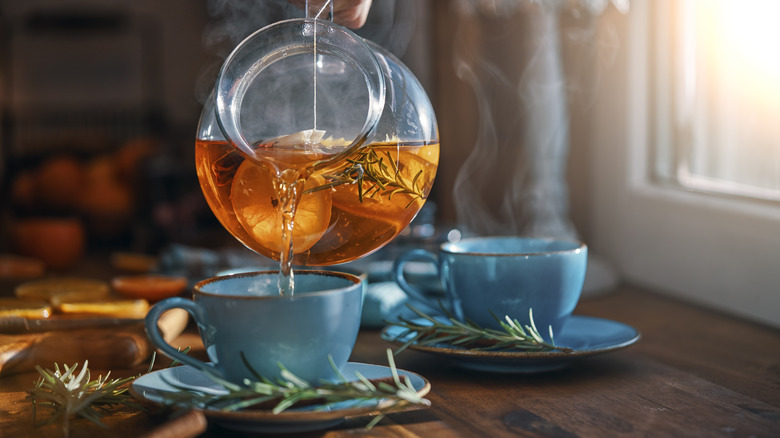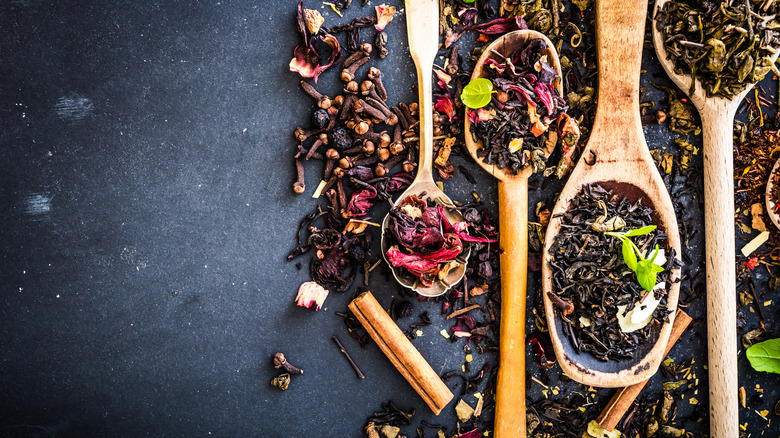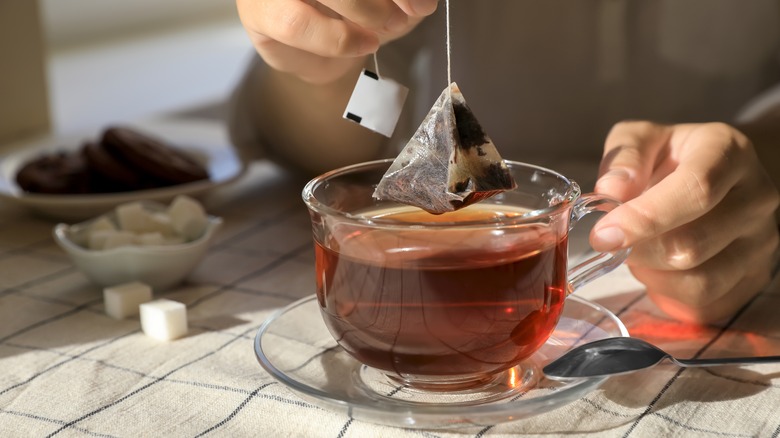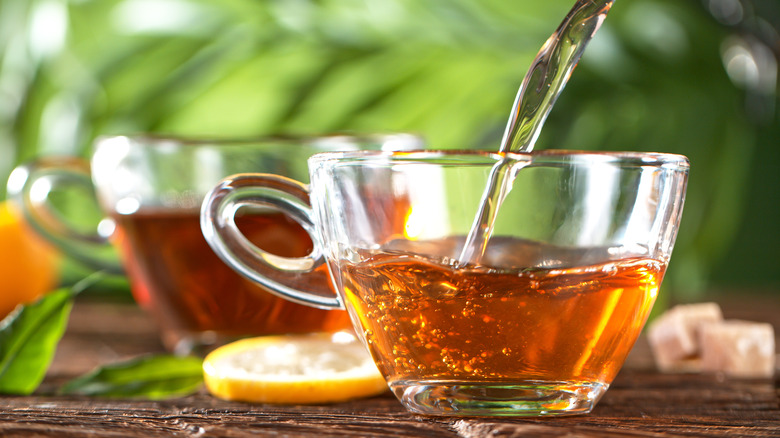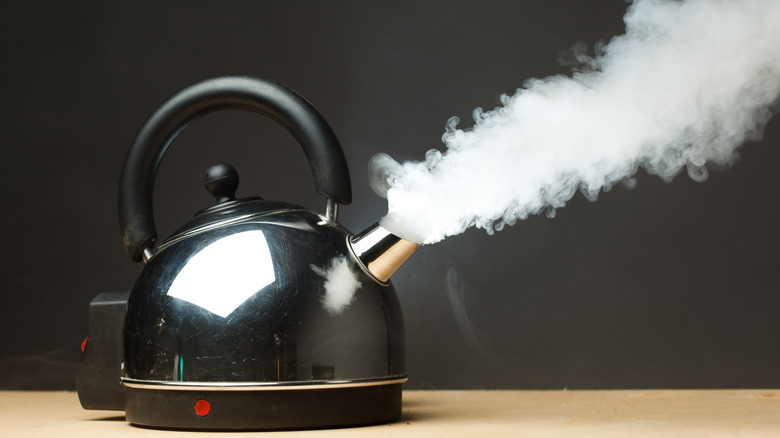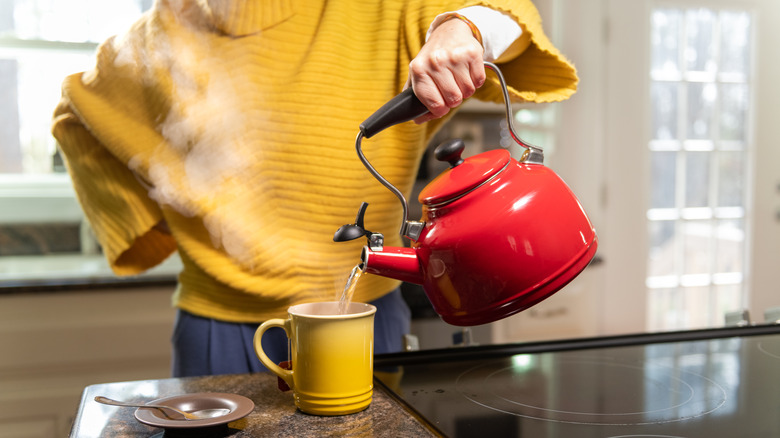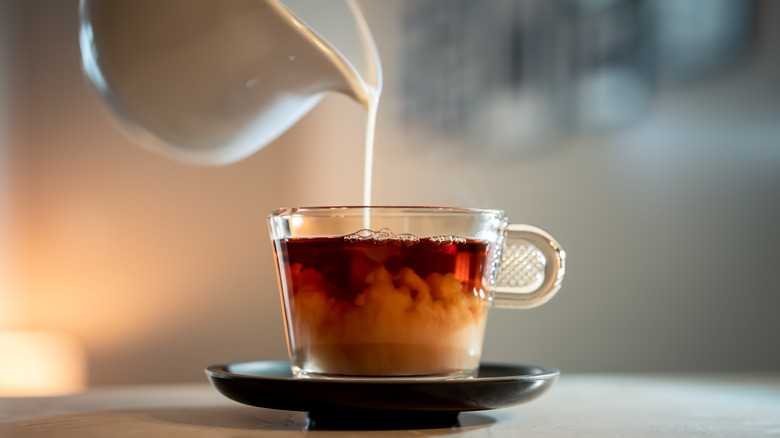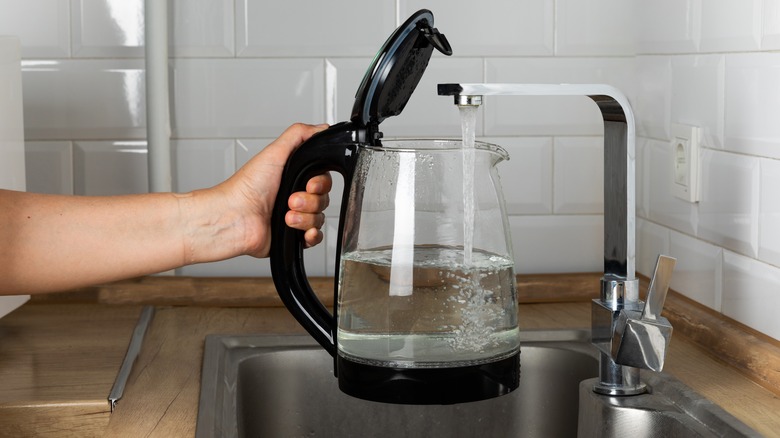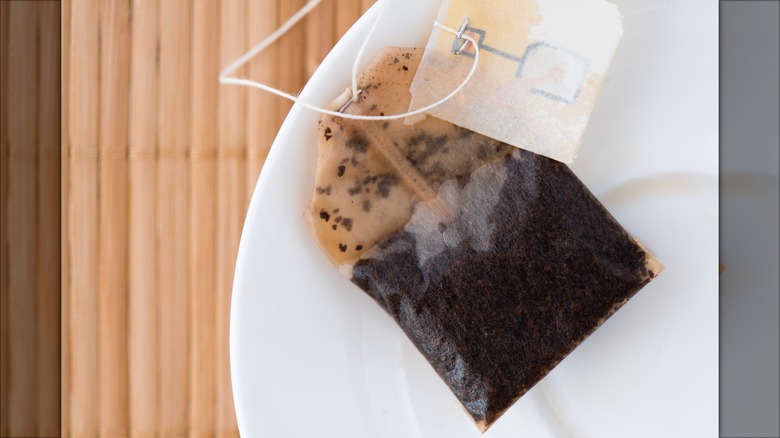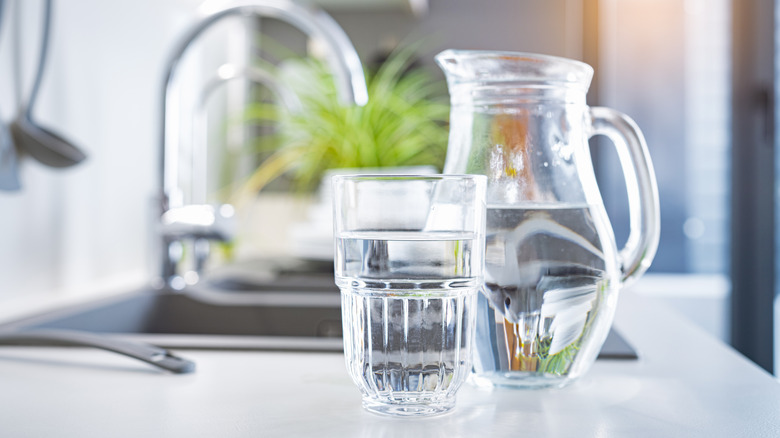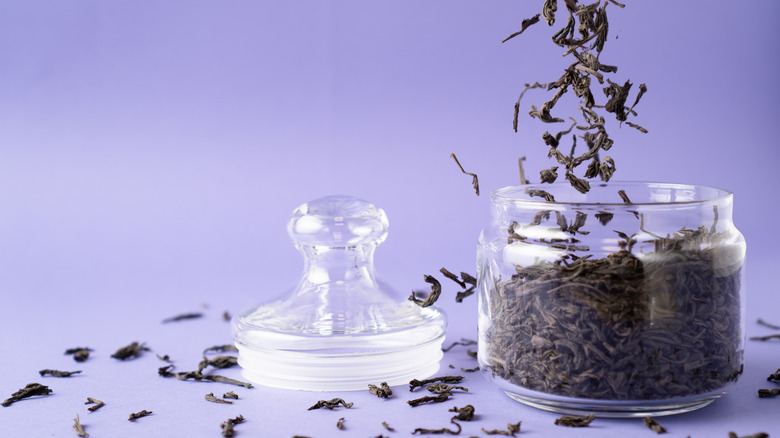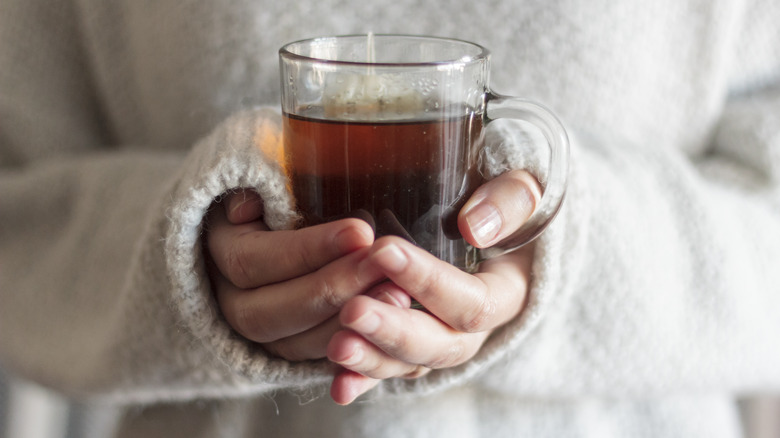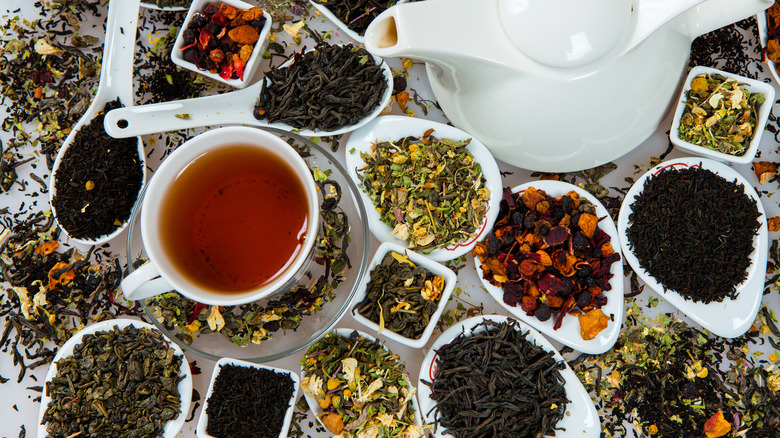12 Mistakes You Might Be Making When Brewing Tea
Tea culture has been around for centuries, spanning the globe. Making a great cup of tea is both an art and a science. In the Southern United States, it's all about getting the ideal ratio of sugar to tea in a glass of iced, sweet tea. Across the world in Japan, it's used in the ritualistic tea ceremony, where everything has its place and there's a meticulous method. Whether it's a quick chai latte grabbed on the go, a steeping pot of Earl Grey at home, or a calming cup of chamomile before bed, brewing the perfect cuppa is a way to connect with traditions and cultures and embrace the deep and expansive history of tea, while still catering to your personal preferences.
Still, even the best of us can make a blunder while brewing at home. Between steeping times, water temperature, and the quality of the tea leaves, understanding these nuances is essential to unlocking the full potential and flavor of the beverage. Otherwise, you could wind up with bland, bitter, or even scorched tea. Fret not, for we're here to help you master the art of making tea at home. Here, we'll delve into some of the many common mistakes that happen when brewing tea so you can enjoy a delicious cup in the comfort of your own home.
1. Opting not to use loose leaf tea
While tea bags offer convenience, loose-leaf tea promises a more aromatic and flavorful cup. Tea bags are affordable, easy to use, and often delicious, so there's no fault in using them. However, loose-leaf tea is undeniably fresher, and often has more natural oils and antioxidants because drying and grinding it up to put into teabags exposes it to more air. Tea leaves also tend to last longer than tea bags. Plus, you aren't putting a barrier between the tea leaves and the water like with a bag (one that isn't always biodegradable), which can blunt the flavor. Moreover, a tea bag can only offer you as much as the bag holds, so you're getting a smaller amount than you would with larger loose tea leaves. In this case, quantity does affect quality because ground tea loses the nuanced, defining flavor characteristics that whole tea leaves have. Also, with loose-leaf tea, you can control the intensity of the flavor in a way that's not as easy with tea bags.
Loose-leaf tea also comes in a multitude of flavors. Some tea varieties, like silver needle white tea, are rarely, if ever, found in tea bags unless specially ordered. Just by going for loose-leaf tea instead, you are apt to try varieties that you wouldn't otherwise. Several grocery stores and online retailers carry a variety of loose-leaf teas, from classic black, green, and herbal teas, to oolong or fermented Pu-erh teas.
2. Steeping tea too long or too little
If you read the instructions on a tea bag, it will likely tell you how many minutes to let it steep in water. But let's face it, sometimes we walk away and leave it longer, sometimes we're impatient and start drinking it early, and sometimes we don't see the instructions at all. However, ignoring those important instructions can actually be detrimental to the flavor of the final cup. In fact, if you steep your tea for too long, you can end up with a bitter taste, whereas too little time and you won't get the full flavor.
This goes for loose-leaf tea and tea bags alike, but there's a trick to getting it right. As a general rule of thumb, steeping times depend on the type of tea. As Artful Tea explains, black tea should typically steep for about 3 to 5 minutes, while white and oolong teas need only 2 to 3 minutes of steeping before they're ready. Green tea takes even less time — only a minute or so — while herbal and rooibos teas take longer than 5 minutes for the best flavor. Herbal teas are one of the few exceptions to the usual brewing rules. Not only can they be steeped in boiling water, but they can be brewed for a longer time without turning bitter like other teas do.
3. Choosing the wrong cup
While many of us opt for our favorite mug, an insulated to-go cup, or even the cleanest, easiest-to-reach option, tea cups are thoughtfully designed to enhance the tea-drinking experience. Figures, right? That doesn't mean you can't use your well-loved mug, but the right cup can make a big difference. Unlike coffee mugs or insulated cups, a good tea cup is purposely designed to allow the tea to cool quickly enough to drink while also releasing the aromas. Just as design matters, so does size. Depending on the kind of tea, you may want a smaller cup, especially if you're a slower tea drinker. For instance, green tea is traditionally served in a small teacup to cool faster, while allowing you to focus on the subtle flavors in a few sips.
After considering design and size, there's also the material. You'll want to go for tea cups made with nonporous materials, like ceramic, porcelain, glass, or metal. Twinings explains how porosity can affect the flavor — nonporous cups are less likely to be hiding unpleasant flavors that might leach into your tea. They also note that the glossy surface of certain materials, like ceramics, won't hold onto the tea's bitter-tasting tannins which may affect your next serving. When picking out a tea cup, it also ultimately depends on how a cup looks and feels to you. Beyond visual appeal, does it feel nice in your hands? Do you prefer sleek glass over classic china? The choice is yours.
4. Not using the proper water temperature
A tea kettle whistling — we've seen it, we've done it, and we've heard it. It's indicative of water boiling, meaning the tea is ready to brew. Contradictory as it may sound, though, using boiling water can actually leave you with a bitter beverage. It all depends on the tea. While herbal teas can stand the rapid boil, other kinds will quickly lose their true flavor. Too hot of water can even scald loose-leaf tea, altering the taste entirely. Conversely, if the water isn't hot enough, you may end up with a dull flavor. Finding the right water temperature can be tricky but once you understand that different teas require a different degree of heat, you'll have better luck figuring it out.
Typically, green tea needs a lower heat while brewing. According to Artful Tea, you should bring the water to 140 degrees Fahrenheit for specialty green teas, like fine Japanese gyokuro, and anywhere between 175 to 180 degrees for other green teas, as well as white and purple teas. Some electric kettles have variable temperature settings to use, but it can otherwise be hard to determine temperature without a thermometer, so a good way to know if your water has reached 175 degrees if it's steaming but not bubbling. Rooibos, herbal, and black teas can withstand a full boil — about 212 degrees. Oolong teas, meanwhile, are best brewed at around 195 degrees.
5. Neglecting to use a teapot
While you might not always be up for a full pot of tea, it's still a good idea to use a teapot when brewing. Not only is it designed to keep the tea warm for longer, as opposed to heating a single cup of water, but it also controls the temperature. Certain tea kettles, sometimes even feature a gauge that shows you exactly what the temperature is. Unlike a single cup, a teapot provides ample space for loose tea leaves to expand fully. This gives you a more balanced and flavorful infusion. Finally, let us not forget about pure aesthetics. By adding an element of elegance and tradition to the tea-drinking experience, teapots can bring an aesthetic perfect for both formal occasions and your cozy kitchen.
When choosing a teapot, you may want to consider the same things you look for in a teacup. Ceramics and glass, for instance, are good insulators and will help keep the tea warm for longer. Jing Tea suggests staying away from metal teapots because most of the heat will stay with the metal instead of the actual water. If you aren't heating the water properly, which can happen with metal pots, you'll likely end up with a weaker brew.
6. Adding too many ingredients
Tea is naturally full of flavor, and when made right, is perfectly delicious without anything added. While you might like adding elements like honey, sugar, or milk to your tea, it's crucial to strike a balance. Overloading with these additives can mask the tea's character, be it the robustness of black tea or the delicate flavor of green tea. Now, we're not going to tell you to drink your tea black as coffee if you really need the milk or sugar. Still, we might encourage you to dial it back a little so you don't overwhelm the beverage with stronger flavors. A splash of oat milk or a tiny drizzle of honey likely won't make a huge difference, but a heaping of these will.
Aside from how it changes the natural flavors, additives can also take away from the health benefits tea offers. For instance, chamomile tea will help you sleep, but if you pile on the sugar, you're going to counteract those natural, calming effects. Likewise, black tea, ginger tea, and green tea can settle an upset stomach, but ingredients like milk can cause indigestion, just as sugar can potentially bring on its own tummy troubles.
7. Getting the wrong water-to-tea ratio
While you can't measure out tea bags, you can measure loose-leaf tea, so getting the correct ratio of tea to water can be challenging. A good starting point is one teaspoon of loose-leaf tea for every 6 ounces of water (per Artful Tea). However, this general rule varies depending on the kind of tea and the size of the teacup. A larger cup will probably need double the amount of tea because it holds closer to 12 ounces. Most kinds of tea follow these guidelines, but white tea is lighter, so it's advised to combine 2 teaspoons of white tea with 6 ounces of water.
This particular ratio matters when brewing tea because if you use too much water, you'll have diluted flavors, while using too much tea will make the flavor extremely concentrated and more bitter. Of course, it also depends on personal preference. You might like your tea strong or you might enjoy just the subtle essence of tea. If you're looking for the perfect cup, though, the ratio is important. From there, adjust as you please.
8. Tossing out your tea bag
Throwing away your tea bag after brewing one cup is a common mistake and one that's very avoidable. Instead of tossing it in the trash right away, you can reuse it once. Not only does it let you savor the full potential of your favorite tea blends, but it minimizes waste. Likewise, if you use a mesh tea ball or disposable filter bags for loose-leaf tea, you can also steep those a second time. Just one reuse will still give you most of the tea's flavor, but it might not be as strong as the first brew. After a third or fourth time, it could start to diminish, so it's best to stick to just one reuse when brewing.
However, you could consider the other things you can do with used tea leaves. If you break open a tea bag, you can mix the brewed tea leaves into baked goods like cookies, bread, or a literal tea cake. Slate suggests blending the tea grounds in melted butter, and incorporating that into your batter. Another way to utilize tea leaves to their fullest is to place used tea bags in the water you heat for oatmeal to infuse your breakfast with distinct flavors, like chai.
9. Not using filtered water
We understand that tap water is not always avoidable, but if you can use filtered water for your tea, it'll make a decent difference in flavor. In the United States, about 85% of the tap water is hard water. Even though the U.S. Department of Energy states that hard water doesn't cause adverse health issues, it does contain impurities and minerals. Some of these can interfere with the delicate flavor of tea and even the composition, from cloudy water to a gritty texture. It could also create a buildup of minerals, meaning your teapot may need a deeper cleaning.
Instead, filtered water can give you a cleaner, truer representation of the tea's intended profile. If you don't have access to filtered water, you can purify your tap water in a few ways. The Centers for Disease Control and Prevention (CDC) recommends boiling water to purify it at home, and using a pinch of salt in a liter of water after being boiled. With or without salt, rapidly boiling water is one of the easiest and best methods to quickly take care of any unwanted germs, cloudiness, or hard minerals from tap water. Remember to make sure to bring the boil back down to a proper brewing temperature so you don't scald the tea leaves.
10. Improperly storing your tea
One of the easiest mistakes to make is simply storing your tea incorrectly. Remember this: Moisture and light are the enemies of tea. Ideally, you should store your tea in a dry, dark place to prevent degradation. Exposure to light, moisture, and air can affect its flavor and aroma, and cause tea to go stale. While the fridge is dark when closed, it's not dry and could introduce moisture, so it's not a prime option for storing tea. Instead, opt for a pantry, drawer, or a corner on the counter that isn't well-lit. You'll also want to keep it away from strong-smelling foods or spices because tea leaves can easily absorb those scents or flavors. We're pretty sure no one wants garlic tea. Keep in mind though, that this also includes other tea — an herbal tea can pick up the aromas of peppermint tea or Earl Grey. We're definitely sure no one wants a mishmash of fruit, mint, and bergamot.
Despite its name, you don't want to keep loose-leaf tea loosely stored. Instead of keeping it in the packaging it comes in, tea leaves should be stored in an airtight container to maintain their freshness. Plastic works, but non-porous glazed ceramic, metal, and glass containers are preferable. Teabags could also benefit from being stored this way, but since they're already technically preserved by the bag, it's not as necessary. Still, tea bags and loose-leaf alike should be stored away from light or moisture.
11. Picking the wrong tea for yourself
Choosing the right tea for yourself involves understanding more about what each variety of tea has to offer. Black teas are bold in flavor, while white teas are much lighter. Oolong, rooibos, and herbal teas come in a vast range of flavors — they can be fruity, earthy, or nutty. Jasmine, Earl Grey, and chai blends are all distinctively aromatic. Then there are more unique teas, like Pu-erh teas. Made of fermented Camellia sinsensis (the tea plant) leaves, this ancient Chinese tea is known for its earthy taste and health benefits, per Healthline, from providing gut support and curbing the growth of cancer cells to its many antioxidant properties. Consider if you're choosing a tea for its health advantages. Stomach cramps or an upset stomach? Go for ginger tea or chamomile. Stress? Try a soothing lavender blend. Tea blends with valerian root can help you fall asleep, while green tea is packed with antioxidants.
It'll also help in knowing how long you need to brew it, and if you want it in the morning or evening. If you're the type of person for a quick cup of tea in the morning, you may want a black English breakfast tea that can steep on your way out the door. At bedtime, waiting for an herbal tea to brew, which requires a full boil and a lengthier steeping time to infuse more flavor, could come as a comfort.
12. Not using high-quality tea
If you want the best possible cup of tea, you should strive to use high-quality tea leaves. While tea bags are convenient, inexpensive, and sold in bulk, they tend to be poorer in quality. They're usually made with ground-up pieces of dried tea leaves called dustings and fannings, which are like the dregs of better tea. When they aren't brewed properly, these small dustings are also prone to bitterness. The next step up in grades of tea leaves is broken tea leaves, which are exactly as they sound — broken bits of larger leaves. They're not quite as low on the totem as dustings and fannings, but they aren't exactly the best quality of tea out there. To experience the complex flavor of tea to its fullest, you may want to consider higher-grade tea.
Nevertheless, the quality varies even among whole tea leaves. When buying loose-leaf tea, it's not unlike shopping for produce. You want to pay attention to how it looks, how it smells, and the size of the leaves. As Tea Culture of the World explains, if the leaves are big, they typically pack more flavor. Additionally, darker tea leaves often are stronger and more flavorful than lighter leaves — a darker green tea, for instance, will have a more robust flavor. If all else fails, rely on your nose. How does it smell? A fruity, herbal tea should smell just like that, and if you're having a hard time detecting any aroma, move along.
